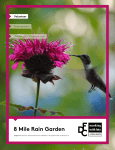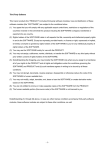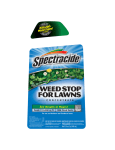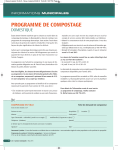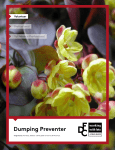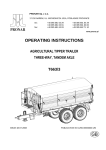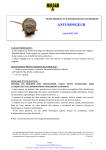Download Full Printable Lot Design - A Field Guide Working with Lots
Transcript
Volunteer Professional Volunteer + Professional Holland Maze Image Source: Illia Frenkel, “Purple Tulips.” 26 September 2014 via Flickr, CC BY-NC-SA 2.0. DRAFT COPY Field Guide | DFC-lots.com | Holland Maze 2 HELLO What is the lot design likely to cost? The estimated cost of the Holland Maze is over $5,500 and based on utilizing volunteer and professional labor. The Field Guide recommends hiring a professional for earthwork and lot preparation. The cost assumes that residents or volunteers have access to basic safety gear and garden tools. MY NAME IS How much upkeep will this lot design require? Holland Maze A high level of maintenance is required for the Holland Maze design to look its best. Maintenance will include weeding and watering plants, particularly during times of drought or excessive heat. The Holland Maze lot design is a playful adaptation of the tulip fields found in the Netherlands. The lot design consists of a series of mounds planted with tulips, lavender and geraniums. The planted mounds create a bold pattern that makes a statement from afar. Will the installation of this lot design require a professional? The Holland Maze features bright summer colors and includes a small rain garden that captures water from the lot or from portions of an adjacent property. This lot design can be installed on a single lot or, for greater impact, on multiple lots. For more information refer to DFC-lots.com Cost $50 - 1,000 The installation of this lot design will require professional assistance for the first few steps. The Field Guide identifies volunteer opportunities if you, with the help and support of friends, family or neighbors, would like to complete the planting portion of this lot design. Please refer to the Step-By-Step section for guidance on professional and volunteer recommended steps. If you do not feel able to tackle the volunteer aspect of this lot design, a professional can construct the entire project. How long will it take to install this lot design? This lot design requires a professional for several steps of the installation. The projected installation time listed below is estimated for the volunteer opportunities detailed in the Step-By-Step section only. While people tackle projects differently, the Field Guide estimates the installation time of this lot design to be one to two full weekends with a volunteer group organized by a knowledgeable lot leader. The Field Guide recommends the help of at least 10 healthy adults or youth to complete this lot design. The Field Guide assumes that the lot is ‘construction ready,’ and all equipment and materials required for the lot design have been acquired and are ready to use. $1,000 - 2,500 $5,500 + $2,500 - 5,500 People Volunteer Professional Volunteer + Professional Experience Beginner Intermediate Advanced Low Medium High Good Better Best Upkeep Stormwater Location Single, Double, or Multiple Lots in Full Sun or Part Sun Field Guide | DFC-lots.com | Holland Maze 3 Holland Maze Examples of Planted Mazes 1 - Lavender Hedge 2 - Tulip Maze 3 - Lavender Section 2’-0” Mulch Path 6’-0” Mound 1’-0” Mulch Path 6’-0” Mound 4’-0” Grass Path Where Do I Grow? Section The Holland Maze can be installed on single, double, or multiple lots and is suitable for corner properties. The image below shows an example of mounds planted with tulips. 4 - Tulip Rows Planted Mounds Rain Garden Mulch Pathways Grass or Optional Groundcover Pathways Image Source: 1) Lori Quillen (SVLover), “Mt Shasta Lavender Farm.” 21 June 2014 via WeatherUnderground, license unknown; 2) Peter Toshiro, “At the Park: Tulip Garden.” 10 April 2011 via Flickr, All Rights Reserved; 3) Peter Reed, “Lavender.” 02 July 2006 via Flickr, Creative Commons Attribution-NonCommerical 2.0 Generic; 4) Peter M Graham, “Tulip_070.” 21 April 2007 via Flickr, Creative Commons Attribution-NonCommerical 2.0 Generic. Field Guide | DFC-lots.com | Holland Maze 4 Before You Start ‘Construction Ready’ This lot design assumes that you have prepared the lot to a ‘construction ready’ state. ‘Construction Ready’ refers to a lot that is clean and clear of trash, hazardous objects, unwanted trees, brush and vegetation, fences, and other unwanted structures. It may be necessary to remove grass in preparation for your lot design. Refer to the Remove Your Grass box located on the right hand side of this page for more information. Is there an available water source near your lot? Consider how and where you will access water during and after construction to ensure that your plants can establish. If your lot is not ready for construction, refer to the Clean + Green lot design. You can find the lot design at DFC-lots.com. Call Before You Dig Locate underground utilities before beginning your lot design. MISS DIG provides a free service to Michigan residents by locating and marking utilities on requested properties. Call (800) 482-7171 or 811 at least three days before you plan to start digging on your lot. Test Your Soil Harmful pollutants have made their way into many urban soils. To proceed with awareness, consider having your soil tested before construction. Two great options are available: Soil testing is free to members of Keep Growing Detroit’s Garden Resource Program. Call (313) 757 – 2635 for more information or visit detroitagriculture.net. If you are not yet a member, you can work directly with Michigan State University’s (MSU) Extension Program. They have a Home Lawn and Garden Soil Test Mailer for $25. For more information call (888) 678 – 3464 or visit msusoiltest.com. If you are concerned about the presence of lead or other contaminants in your soil, call the Michigan Department of Health and Human Services at (866) 691 – 5323 or (800) 424 – LEAD. Remove Your Grass Need to remove grass in areas where you are constructing your lot design? There are many ways to remove unwanted grass. The first is to remove the grass and its root system by digging up the grass. Another option is to cover your lot with cardboard or a plastic tarp to smother your grass in darkness. It will take several weeks, but after being covered, the dead grass will be easier to remove. Till Safely Before you till, inspect your lot for signs of buried concrete or rubble that was not removed during the cleanup stage. Large debris can ruin tiller blades. When tilling, wear appropriate safety gear, such as covered boots with socks, long pants, safety glasses, dust mask, and ear protection. Make sure you understand the safe operating procedures of your tiller. Refer to the user’s manual. Field Guide | DFC-lots.com | Holland Maze 5 What You Need: Shopping List Shopping List Materials MaterialsList List The shopping list provides a breakdown of potential materials, tools, and resources required to construct this lot design. Materials This shopping list is designed for a single lot (30 by 100 feet). Tools + Resources Suggested Tools ·· Marking Paint, Spirit Level, and Tape Measure ·· Safety Gear: Gloves, heavy work boots, tall socks, pants, long sleeve shirts, dust masks, protective eye wear, ear plugs, and hard hats (if using heavy machinery) ·· Garden Tools: Spades, shovels, rakes, trash bags, and wheelbarrows ·· Hacksaw and Screwdriver ·· Rain Garden Planting Soil, 1.5 cubic yards (50% sand, 25% topsoil, and 25% compost or leaf litter) ·· Mulch or Wood Chips, 4 cubic yards (rain garden and mulch pathways) ·· Bonemeal or Pine Bark, 1 bag ·· Downspout Disconnect: Standpipe cap, downspout elbow, downspout connection pipe, rubber cap, and hose clamp Planting ·· Violet Intrigue Lavender, 69 pots ·· English Lavender, 69 pots ·· Giant Hyssop, 70 pots ·· Mixed Tulips, 520 bulbs ·· Rozanne Cranesbill, 30 pots ·· Cranesbill Geranium, 30 pots ·· Purple Cranesbill, 31 pots ·· Mixed Poppies, 1 pound of seed ·· Blue Chip Jr. Butterfly Bush, 16 pots ·· Tiller, 6 inch depth Potential Water Sources ·· Garden Hose with possible extension hose ·· Sprinkler ·· Rain Barrel in addition to other water source ·· Downspout Disconnect (shown in lot design) Field Guide Resources Resources are available on the Field Guide’s web site. ·· Clean + Green ·· Perennials + Grasses Planting Detail ·· Bulb Planting Detail Pathway Groundcover: ·· Low-Maintenance Fescue Mix, 6.5 pounds of seed ·· Germination Blanket, 3 rolls (4 by 112.5 feet) Field Guide | DFC-lots.com | Holland Maze 6 Holland Maze Step-By-Step Let’s Start Want to create the Holland Maze? The Field Guide recommends hiring a professional for some tasks. Here are a few guiding principles to help you understand the tasks involved in the lot design and the steps appropriate for volunteers. Check off tasks as you go along. Lot Design Steps Professional Recommended: Prepare Your Lot Create Mounds + Mulch Pathways Dig Rain Garden Volunteer Opportunities: Disconnect Your Downspout Plant Perennials + Bulbs Sow Poppies Grass Pathways Maintain Your Lot Prepare Your Lot The Holland Maze is one of the more complex lot designs in the Field Guide. It is recommended that you hire a professional for these steps: Prepare Your Lot, Create Mounds + Mulch Pathways, and Dig Rain Garden. If you decide to construct this lot design without the recommended assistance of a professional, the Field Guide has provided guiding principles below to help assist you with the installation of the lot design. This lot design utilizes a full 30 by 100 foot single lot. For greater impact, the Field Guide recommends implementing the design on multiple lots. Till the existing soil six inches deep to loosen the ground. Once the area is ready for construction, use marking paint and a tape measure to map out the size, shape, and dimensions of the Holland Maze design. Create Mounds + Mulch Pathways To create mulch pathways, excavate four inches of soil. Pathways are a combination of one foot and two foot widths of varying lengths. Add three inches (2.5 cubic yards) of wood chips or mulch to the excavated mulch pathways. The mulch pathways are designed for easy access to the plant beds for weeding and stormwater collection. Use excavated soil to build mounds up to a maximum height of six inches. The six inches of mounded earth will form six foot wide planting beds. Field Guide | DFC-lots.com | Holland Maze 7 Holland Maze Step-By-Step Dig Rain Garden Once the area is ready for construction, dig out one foot within the rain garden area and place removed soil on adjacent mounds. The rain garden is approximately 150 square feet. A rain garden only works if water is directed into it. The Field Guide recommends constructing your rain garden near downspouts from roofs of houses or garages or near other hard surfaces such as driveways or patios. Ensure water flows from these surfaces into your rain garden. Your rain garden should be one square foot for every ten square feet of stormwater area directed into your rain garden. If you are unable to direct water into the rain garden area, don’t worry! The garden will still provide habitat to butterflies and aesthetic value as a small garden. After removing the soil, check that the bottom of the rain garden is level. An easy way to check this is with a string level or a spirit level attached to a two-by-four board. A level bottom is important to maximize infiltration and minimize the chance of standing water in the rain garden. After leveling the bottom, the soil should be prepared by scarifying, raking, or tilling the soil four to six inches to loosen up any compaction. Add three inches (1.5 cubic yards) of rain garden planting soil to your rain garden and top with three inches (1.5 cubic yards) of wood chips or mulch after planting. Adding wood chips or mulch will help suppress weeds. Rain garden planting soil should consist of approximately 50% sand, 25% topsoil, and 25% compost or leaf litter. Mix together and place in rain garden. Disconnect Your Downspout One of the easiest ways to collect stormwater is by disconnecting your downspout and directing it into your rain garden. Before you start, remember that disconnected downspouts should extend at least six feet from any house foundation and five feet from adjacent property or public sidewalk. Avoid disconnecting downspouts where they might discharge water across walkways, patios, or driveways or where they might be a tripping hazard. Do not disconnect directly over a septic system. Follow these steps to help you redirect your roof water into your rain garden. ·· Measure the existing downspout, and mark it approximately nine inches above sewer connection or standpipe. ·· Cut with a hacksaw and remove cut piece. ·· Plug or cap the sewer standpipe with a rubber cap secured by a hose clamp. Use screwdriver to tighten and secure cap. ·· Attach elbow joint over the downspout. ·· Add downspout extension to elbow joint. Extension should be length needed to carry water away from house and towards rain garden. ·· Secure pieces with sheet metal screws at each joint. ·· Use plastic or concrete splashblocks, rocks, flagstone, or boulders at the end of the downspout to control erosion of soil and plants in the rain garden from stormwater. For more information, refer to the DWSD’s How to Disconnect a Downspout document. Don’t worry if you are unable to direct water into the rain garden area. The garden will still provide habitat to butterflies and aesthetic value as a small garden. Field Guide | DFC-lots.com | Holland Maze 8 Holland Maze Step-By-Step Plant Perennials + Bulbs Sunny to partly sunny plantings are recommended for the Holland Maze. If your lot is in shade, seek alternative planting options. Add a small handful of pine bark, bone meal or organic food to the soil while planting lavender cultivars and tulips. This will give perennials and bulbs a nutrient boost. Place plants and bulbs in the desired location, then remove plastic pots, loosen roots, and plant. Bulbs should be planted between perennials. For more guidance on planting perennials, refer to the Perennials + Grasses Planting Detail and Bulb Planting Detail. Sow Poppies Soil should already be loosened and prepared for seeding after tilling and sculpting the mounds. If the soil is compacted, rake the mounds this will allow for easier seed germination and better water infiltration. Seeding should take place in either spring (midMay to mid-June) or fall (mid-October to end of November). There are multiple suppliers of poppy seed mixes suitable for the Holland Maze design. American Meadow’s California Poppy Seeds Splendid Mix is one recommended example. American Meadow suggests 0.5 pounds of California Poppy Seeds Splendid Mix per 1,000 square feet. The Field Guide recommends one pound of California Poppy Seeds Splendid Mix for all perennial beds in the lot design. Spread seeds across all perennial beds. You can do this by hand or with a hand-cranked whirlwind seeder. It is likely that you will need to do this several times over the bed. Gently water seedlings daily until they are four to six inches in height. Poppies should grow between perennials and add color and texture to your garden. Poppies are best seeded after the perennials have been planted when the beds require no additional construction. Grass Pathways Turf pathways are best seeded after all work and clean up has taken place on the lot. The Field Guide recommends a fescue seed mix for a low-maintenance lawn alternative. This family of floppy grasses is drought-resistant and requires one cutting (in August or September) per year. Fescue can be established in full sun to shade and should be seeded in spring (mid-March to mid-May) or fall (August to September). Seed mix should be applied to damp lot. Sow seeds by using a seed spreader or by hand across the grass pathways. You may need to do this several times to get even coverage. The Field Guide recommends a seed rate of five pounds per 1,000 square feet. If you follow the Holland Maze lot design, you will need approximately 6.5 pounds of fescue seed mix for the grass pathways (1,278 square feet). Do not sprinkle seeds on planting mounds or on mulch beds. Placing a thin layer of straw or a germination blanket over seeded areas will help ensure that your seed establishes by keeping seeds from blowing away and protecting them from birds. Germination blankets or straw can be purchased at most nurseries and garden stores, including Detroit Farm and Garden. A 30 by 100 foot lot will require three 4 by 112.5 feet single net germination blankets. Gently water seedlings daily until they are four to six inches in height. Once established, grass will not require supplemental watering except during unusually dry periods. Eco-Turf Low Maintenance Fescue Mix is one recommended seed mix and can be purchased through the Michigan Wildflower Farm. Other Field Guide lot designs can be used as groundcovers. Check out the web site for additional options and ideas. Field Guide | DFC-lots.com | Holland Maze 9 Holland Maze Step-By-Step Maintain Your Lot Design Plants require care and maintenance to thrive. Water and weed plants regularly, especially during the first few years. As mulch pathways biodegrade into soil, place the newly created soil onto the mounds. This new soil will be rich in nutrients and a welcome food source for established plants. Add new mulch to pathways and continue the process throughout garden’s life span. Low-maintenance fescue mix should be watered daily until seedlings are four to six inches in height. Once established, grass will not require supplemental watering except during unusually dry periods. Rain gardens are a work in progress. Bulbs and perennials may need to be replaced to keep the garden dynamic and playful. Be creative and make it your own! Visit the Resources page on the Field Guide’s web site (DFC-lots.com) to discover other vendors and places to purchase plants. Average Height of Plants Average Height of Plants 20’ 15’ 10’ 5’ 2.5’ Perennials and Bulbs Field Guide | DFC-lots.com | Holland Maze 10 Holland Maze Lot Design Alley 5 +0 .5 Refer to the Construction Package for more details - located at DFC-lots.com +0 .5 +0 ’ 1 .5 ’ Individual Plant +0.5’ ’ Contour 4 3 -0.5’ +0 .5 ’ +0 .5 ’ 2 downspout connection +0 .5 +0 ’ .5 ’ House House +0 .5 +0 ’ .5 ’ 1 +0 .5 +0 ’ .5 ’ Sidewalk Road 1 1 Planted Mound (Lavender & Tulips) 0’ 2 Planted Mound (Geraniums & Poppies) 3 Rain Garden 4 Grass or Optional Groundcover 4’ 8’ 5 16’ Mulch Pathway Field Guide | DFC-lots.com | Holland Maze 11 Planting: Full Sun to Part Sun Violet Intrigue Lavender 1 Lavendula angustifolia ‘Violet Intrigue’ 24” Height x 18” Width Blooms July - August Fragrant Flowers Quantity: 69 pots English Lavender2 Lavendula angustifolia ‘Hidcote’ 24” Height x 18” Width Blooms July - August Fragrant Flowers Quantity: 69 pots Giant Hyssop3 Agastache ‘Blue Fortune’ 24” Height x 18” Width Blooms July - September Fragrant Flowers Quantity: 70 pots Mixed Tulips4 14” Height x 8” Width Blooms April - May Avoid Planting in Wet Soil Conditions Quantity: 520 bulbs Rozanne Geranium5 Geranium ‘Rozanne’ 18” Height x 18” Width Blooms May - July Quantity: 30 pots Cranesbill Geranium6 Geranium sanguineum 18” Height x 18” Width Blooms May - July Quantity: 30 pots Purple Cranesbill7 Geranium magnificum+ 18” Height x 18” Width, Blooms May - July Quantity: 30 pots Mixed Poppies8 18” Height x 12” Width Blooms May - June Quantity: 1 lb. of seed Plant Sizes Blue Chip Jr. Butterfly Bush9 Buddleia davidii ‘Blue Chip Jr.’ 18” Height x 18” Width Blooms June - August Attractive to Butterflies Quantity: 16 pots Pots: Plants can be purchased in one to five gallon pots. Size of pots can change based on availability. Bulbs: Bulbs are cheaper if purchased in bulk. You can find bulk bags at garden stores. Seeds: Mixed poppies can be purchased in seed form. The larger the pot, the greater the impact your design will have when first installed. Image Source: 1) Lavender Blue, “Limbo Poet Having a Break for a While.” 07 July 2007 via Flickr, CC BY-NC 2.0; 2) Peter Reed, “Lavender.” 02 July 2006 via Flickr, CC BY-NC 2.0; 3) “—char—“, “Bumblebee back.” 18 July 2008 via Flickr, CC BY-NC 2.0; 4) MookieLuv, “Mixed rows of tulips.” 18 April 2010 via Flickr, CC BY-NC 2.0; 5) “Mwms1916”, “’Rozanne’ geranium blooms.” 21 June 2012 via Flickr, CC BY-NC 2.0; 6) Tapio Kaisla, “Wood Cranesbill (Geranium Sylvaticum).” 18 June 2009 via Flickr, CC BY-NC-ND 2.0 UK; 7) “Color Line”, “Rosestorkneeb – Geranium magnificum No 2.” 21 June 2005 via Flickr, CC BY-NC 2.0; 8) Becca Taylor, “Mixed Popies.” 07 June 2005 via Flickr, CC BY-NC 2.0; 9) Ptelea “Buddleja davidii ‘Dart’s Purple Rain’” 28 July 2012 via Wikimedia, CC BY-SA 3.0 Field Guide | DFC-lots.com | Holland Maze Alley 12 Planting: Full Sun to Part Sun 5 Key 1 2 3 Lavender (Violet Intrigue & English), Giant Hyssop, & Mixed Tulips (Space lavender approximately two feet apart and mix evenly. Space tulips evenly between Lavender.) 1 Geranium (Rozanne & Cranesbill) & Poppies (Space geraniums approximately two feet apart and mix evenly. Sprinkle poppies over perennial bed after geraniums have been planted.) Blue Chip Jr. Butterfly Bush (Space approximately three feet apart and mix evenly.) 3 2 4 House 1 Field Guide | DFC-lots.com | Holland Maze 13 Did You Know? Professionals Can Help! The Field Guide to Working With Lots provides a Construction Package for each lot design. The Construction Package includes information and details required for a professional to construct this design. On the Field Guide web site, use the Construction Package link located near the top of this lot design page to download and print. Your selected professional will then be able to provide a cost estimate and schedule based on the condition of your lot and the design you select. Want to Hire Locally? DFC-lots.com has a growing list of Detroit-based professionals and suppliers of landscape materials and services. Helpful Facts ·· Tulips still grow after they are cut and continue to bloom for 3 to 7 days in a vase. ·· There are currently about 150 species of tulip bulbs with a total of 3,000 different varieties; however, not all tulips will grow in Michigan. Make sure you speak to a professional before purchasing tulips for your lot design. ·· The recommended plants for this lot design have been selected for beauty, habitat creation, and local availability. ·· Lavender can be harvested for oil. ·· Rain gardens capture, hold, and release stormwater gradually back into the soil. ·· Looking for more information on rain gardens? The Sierra Club of Detroit has been running a rain garden program since 2012 and is happy to help. Planting Tips ·· Call ahead to be sure the nursery or garden store has the plants you need for your lot design. ·· The best time to plant is in spring or fall. ·· Do not plant in extreme heat. Still unsure of where to start? Call (313) 294-LOTS or email fieldguide@detroitfuturecity. com for assistance. ·· Water after planting and as needed. Do not let plants dry out. ·· Weed weekly or as needed. ·· Sprinkle a handful of pine bark, bone meal, or organic bulb food in hole with tulips for added nutrients. Field Guide | DFC-lots.com | Holland Maze 14 Draw Your Lot Field Guide | DFC-lots.com | Holland Maze Holland Maze Field Notes 15 Field Guide | DFC-lots.com | Holland Maze 16 Visit DFC-lots.com #DFClots Image Source: Peter Toshiro, “At the Park: Tulip Garden.” 10 April 2011 via Flickr, All Rights Reserved.




















